Program Report on MSDC's November Presentation by Ray McDougall
by Andy Thompson, MSDC Secretary (with thanks to Ray McDougall for his much appreciated edits)
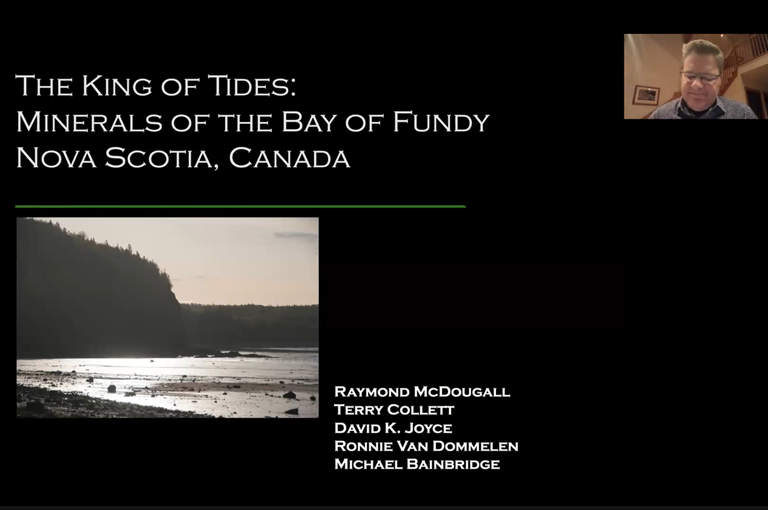
Ray McDougall is a life-long mineral collector who has traveled the world looking for interesting specimens. His presentation to MSDC and its accompanying extensive slide deck, he noted, would not have been possible without collaboration with four close friends named in the above slide. All are avid collectors who have, as a team, collected extensively in the Nova Scotia Bay of Fundy area.
Adding significance to Ray’s presentation is the fact that some of the best mineral specimens found in the area are largely unknown to collectors, as explained below. His presentation tonight hopes to address this problem by helping the community of mineral collectors become aware of the marvelous specimens that originate the Bay of Fundy area.
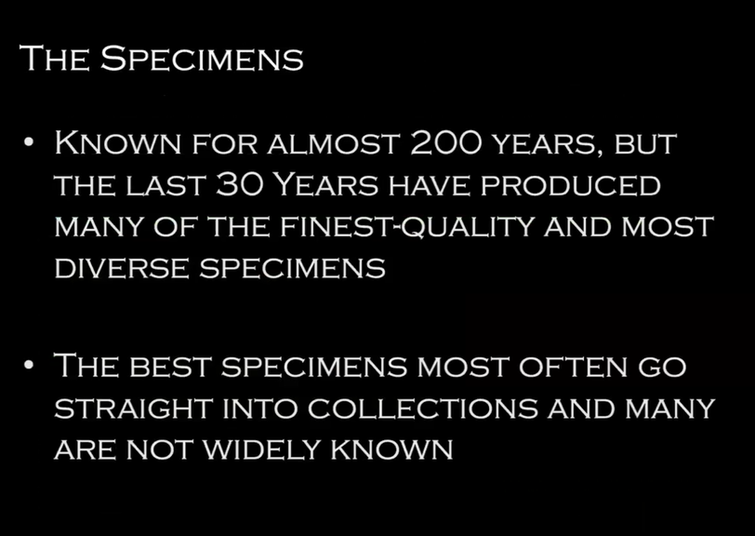
Two factors contributing to this lack of awareness, Ray noted, is that given the excessive tides, the collecting sites are dangerous and often take extreme effort to find and explore. As a result, those minerals that are found, understandably often go from the field straight into private collections, hidden from the public.
“What I wanted to make sure of in tonight’s presentation is that I captured some of the best material... My goal is to open people’s eyes to how amazing the specimens are from this area.”
A quick note to readers: The purpose of this write-up of Ray’s presentation is to encourage you to click on the link below which will take you to the actual video of his talk which includes extensive images of the extraordinary minerals he and his friends have collected from four of the Nova Scotia localities along the Bay of Fundy.
The King of Tides: Minerals of the Bay of Fundy - Ray McDougall
Here is Ray’s outline for his presentation:
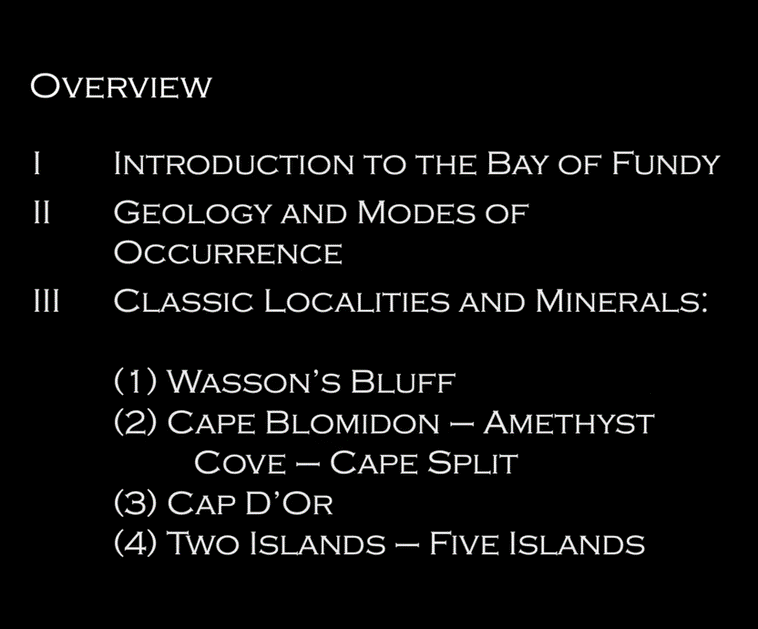
Ray said he would provide a brief introduction to the Bay of Fundy and its geology and then spend most of his presentation on the third point, the mineral specimens from four collecting areas.
I. Introduction to the Bay of Fundy
As a typical example of many of the Bay area’s collecting sites, the following image shows 300-foot-high cliffs common in the area. The incoming high tide, which scours the cliff base and upper regions before withdrawing, leaves behind newly uncovered dark basalt minerals. The uniquely powerful tides constantly erode the cliffs and that is the process which leads to finding and extracting extraordinary mineral samples.
Since the 1830s, and especially over the last three decades, the Bay area has become famous for its spectacular zeolites and associated minerals. “Finding great specimens is super hard work.” Access to those cliffs is difficult because of their height as suggested by the image below. Also, the 12-hour tide cycle limits the amount of collecting time available. “But finding the amazing specimens is worth the effort.”

The Bay of Fundy begins off the coast of Maine and is located between Nova Scotia and the Province of New Brunswick, as shown on the map below. The tide rushes in from the southwest and moves toward the northeast, twice daily. The amount of the tidal water flow is shocking and each tide is estimated to be 14 billion metric tons of water, which is more than the flow of all the world’s rivers combined. It flows through Cape Split running northeast at tidal heights measuring 50 feet, and then reverses and returns to the southwest.
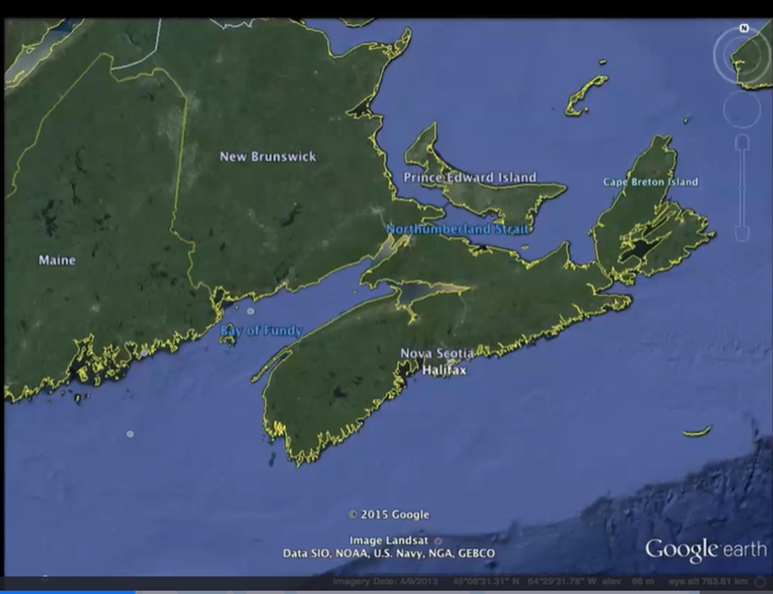
The four localities Ray discusses this evening are shown on the map below and they are among the best collecting areas of the Bay. The minerals are found in veins and cavities within the basalt.
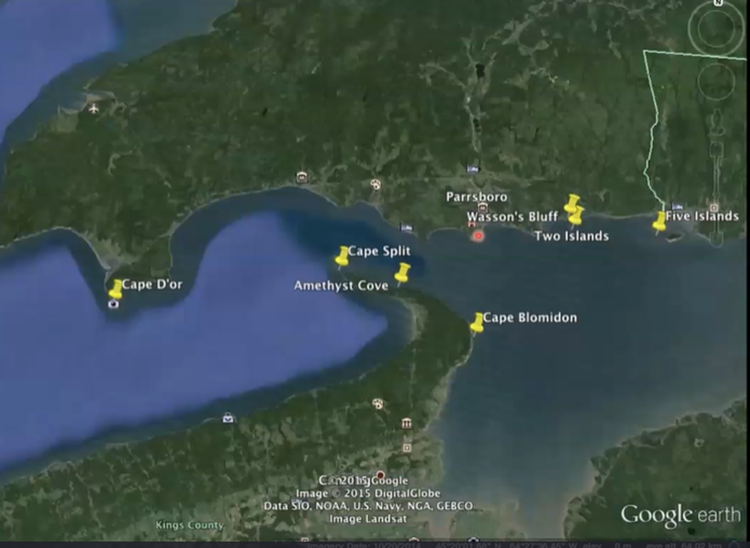
II. Geology and Modes of Occurrence
Ray provided a brief overview of the geology of the region. Sandstone, siltstone, and dinosaur fossils are found throughout all the collecting sites, but it is the Triassic lava flows which now contain the minerals of interest.
During formation, as the lava cooled, cracks, pockets, and bubbles formed in the basalt. These voids were later saturated with mineral-rich fluids and eventually upon cooling the fluids crystalized into specimens of interest.
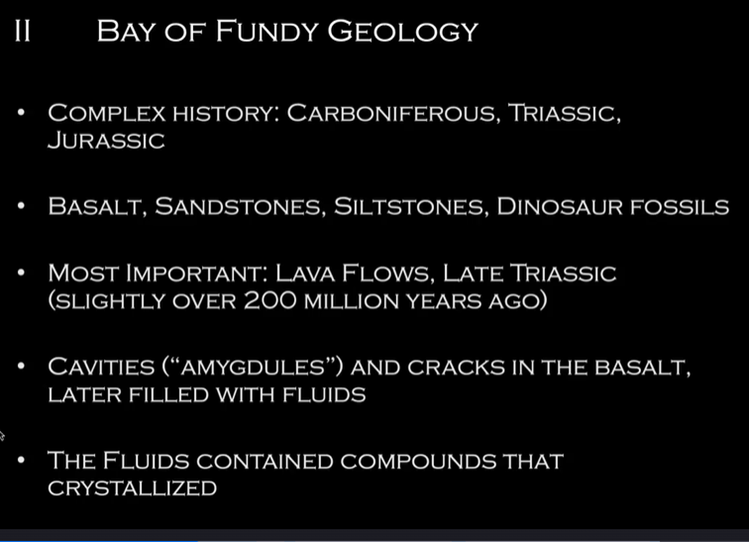
“That is what collectors are looking for: veins and pockets.” The image of Wasson’s Bluff below shows an example of the desired strata of the darker basalt, but also of layers of lighter brownish red sandstone which have no interest for mineral collectors.
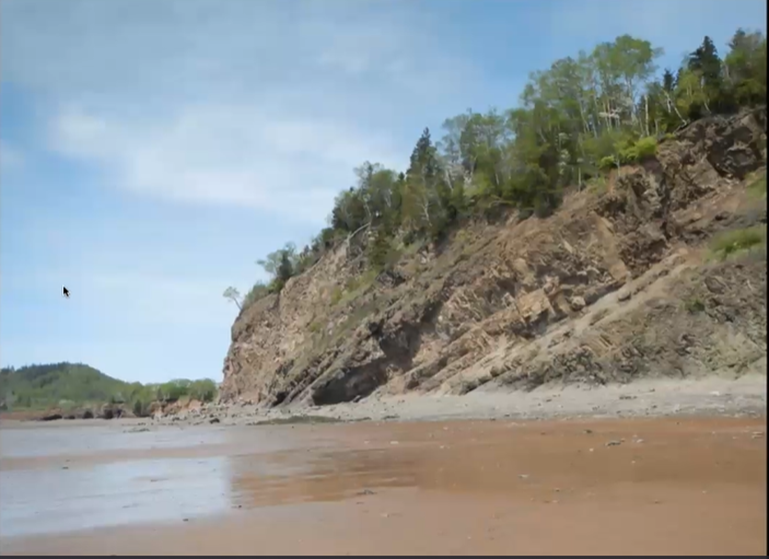
In contrast, the photo below shows dark basalt which is replete with white vesicles filled with silicates and other minerals of interest. Although these small openings are too small to hold significant mineral specimens, they help explain of the process of mineral formation.

On the other hand, sometimes the strong tidal action gives collectors a gift by dislodging a chunk of a cliff, bringing it down to the beach as shown below. That provides collectors with access to the comparatively large veins and pockets in the basalt.
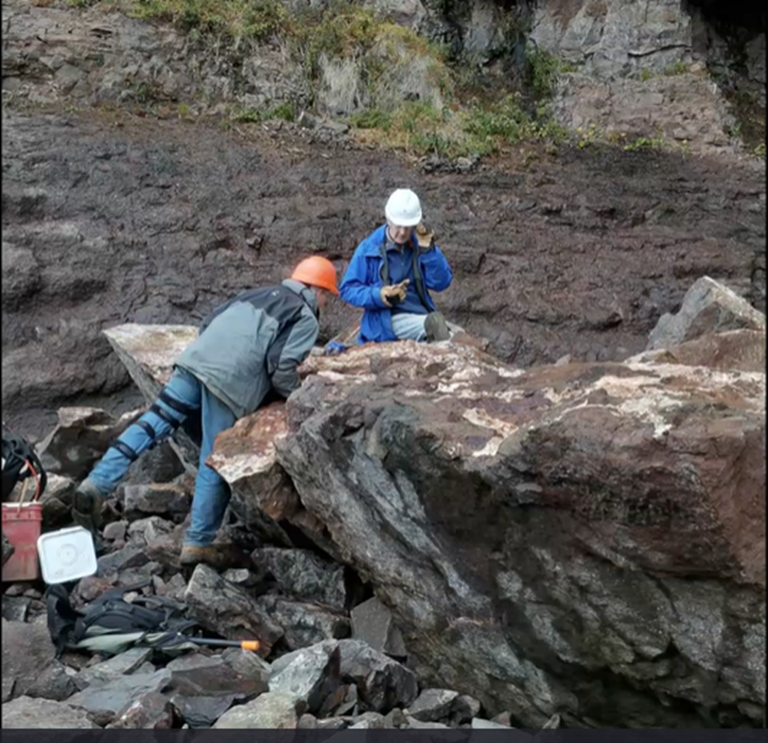
Ray provided the voice of experience by cautioning would-be Bay of Fundy collectors to learn everything they possibly can about the timing of the tides. Lives have been lost due to novices’ lack of knowledge of this important variable. Also, although the tides continually make mineral deposits available, tides also crush some specimens and make fragile overhanging cliffs a danger for collectors.
III. Classic Localities and Minerals
(1) Wasson’s Bluff. The first of the four localities Ray chose to share with his audience, is probably the most famous collecting site along the Bay of Fundy. Many mineral species can be found there, and the best chabazite specimens are world-class.
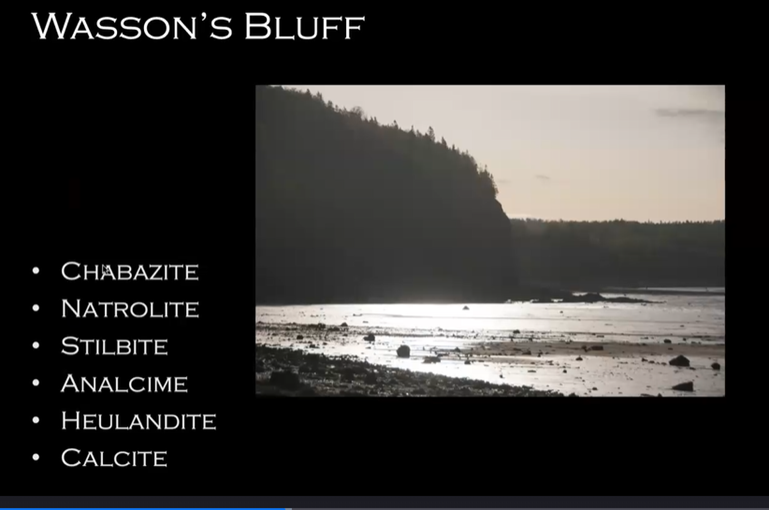
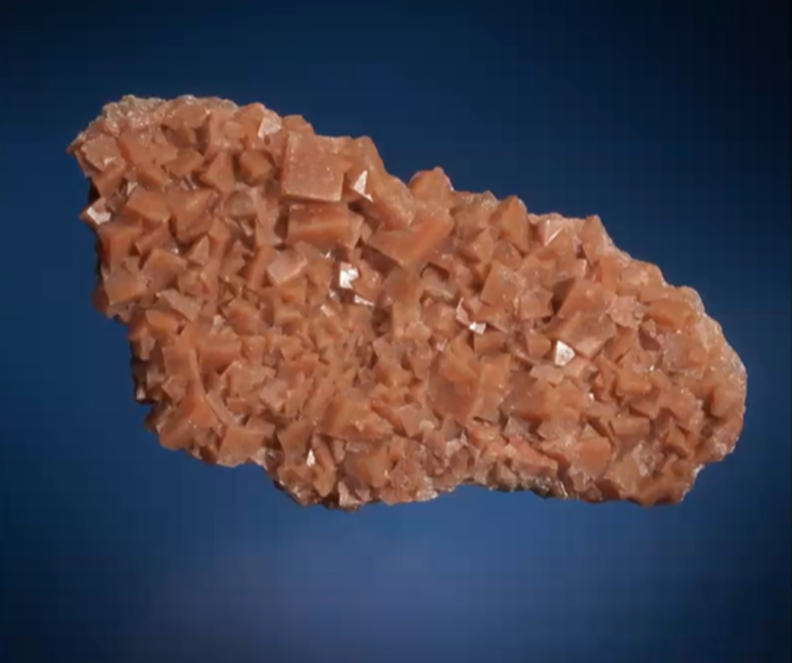
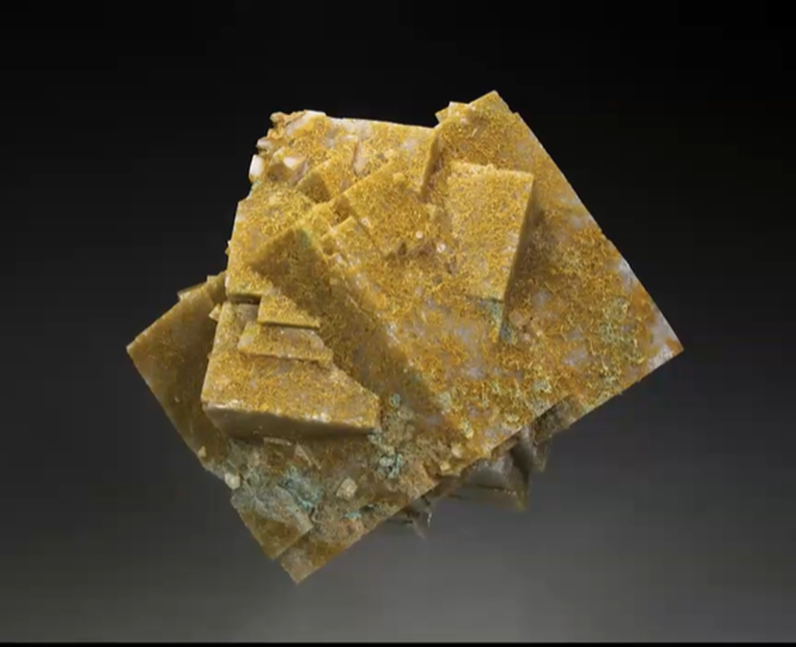
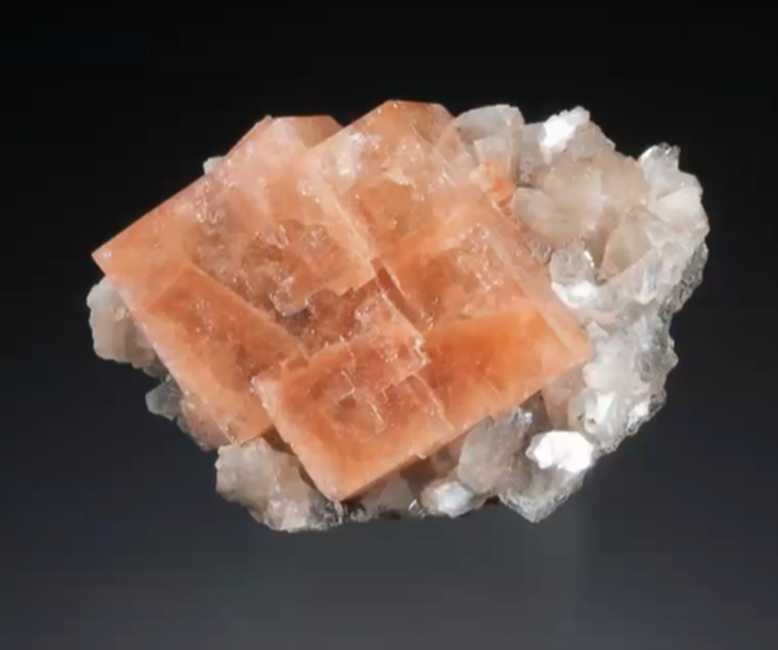
Ray spends a lot of time carefully taking photographs of minerals as it evident from those found throughout this program report. He pointed out the glassy appearance of the crystal faces on the right-hand side of the specimen below. Sometimes he chooses to avoid creating reflections on the crystal faces because this obscures the specimen’s colors. But the photo below includes some reflections to allow viewers to see the considerable detail of the growth patterns on the crystal faces.
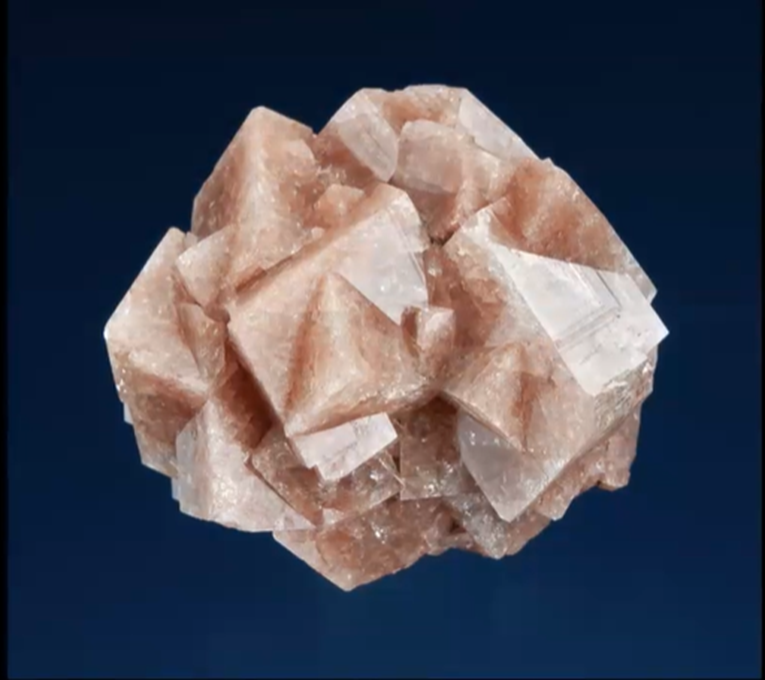
Ray showed additional examples of what he described as world class chabazites - the one below from Terry Collett’s collection is a pristine red chabazite “having not a nick on it.”
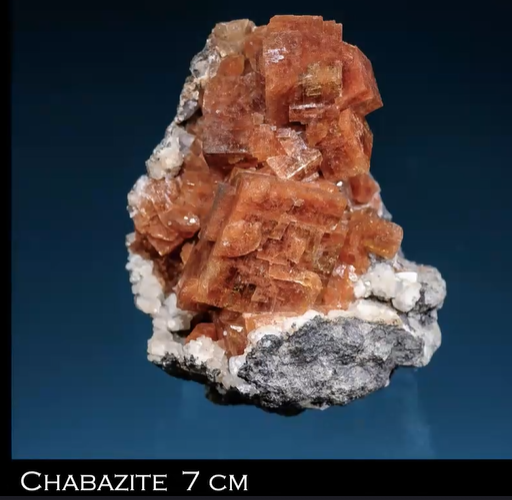
The following chabazite from Ronnie Van Dommelen’s collection has a beautiful vibrant orange color, contrasting with sparkling silvery heulandite. It captures the attention of all who see it.
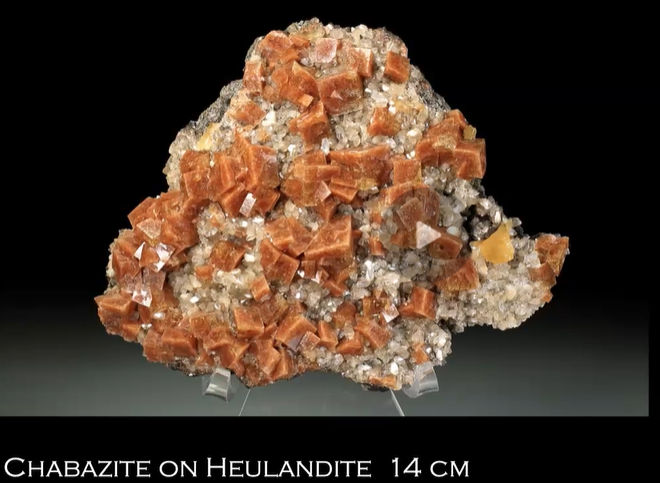
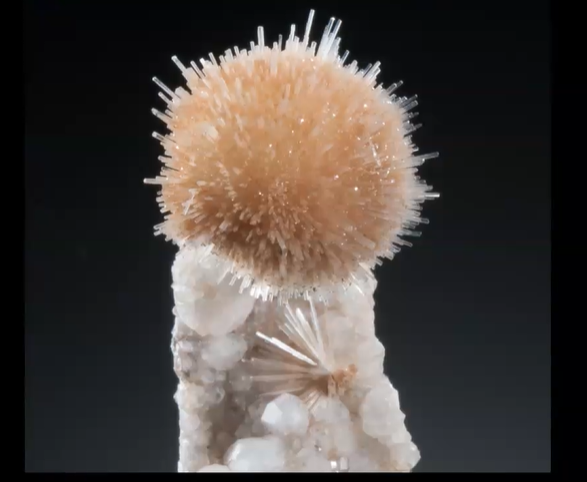
Ray showed many additional specimens which illustrated why Wasson’s Bluff is such a well-known and favorite site for collecting in the Bay of Fundy area.
To view the additional spectacular specimens from Wasson’s Bluff, a reader can click on the following link which will take you directly to MSDC’s YouTube channel where you can open the recording of Ray’s presentation (length: 66 minutes).
The King of Tides: Minerals of the Bay of Fundy - Ray McDougall
(2) Cape Blomidon, Amethyst Cove and Cape Split. The second collecting area Ray described is the Blomidon Peninsula, south and east of Wasson’s Bluff, across the water.
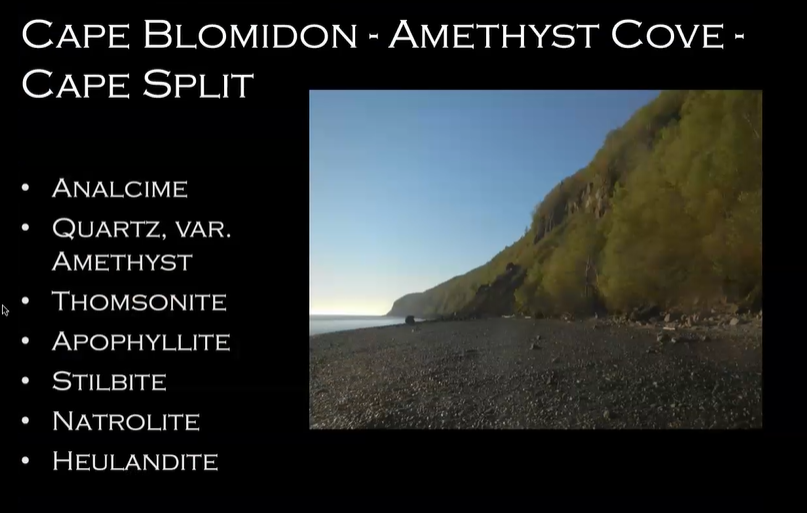
Amethyst Cove and the other sites on the Blomidon Peninsula are especially known for the analcime. Many additional minerals are also found there, including those listed above. Collecting along the peninsula requires a fair bit of hiking. On the west side, shown below, some of the cliffs are not as high. The landscape throughout is beautiful.
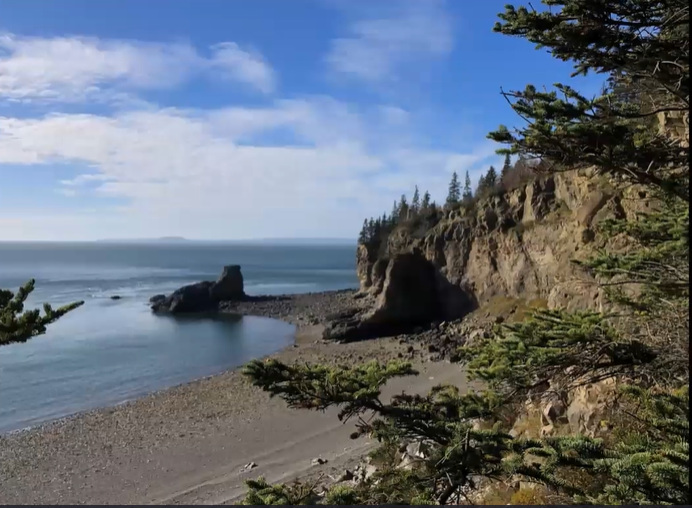
Because hiking along the peninsula is strenuous, especially to get to the northern tip of the peninsula, collectors may be tempted to consider getting there by boat. However, the 1842 engraving pictured below may be worth noting. Ray said few collectors pursue taking a water route to the Blomidon Peninsula localities because the waters can be treacherous.
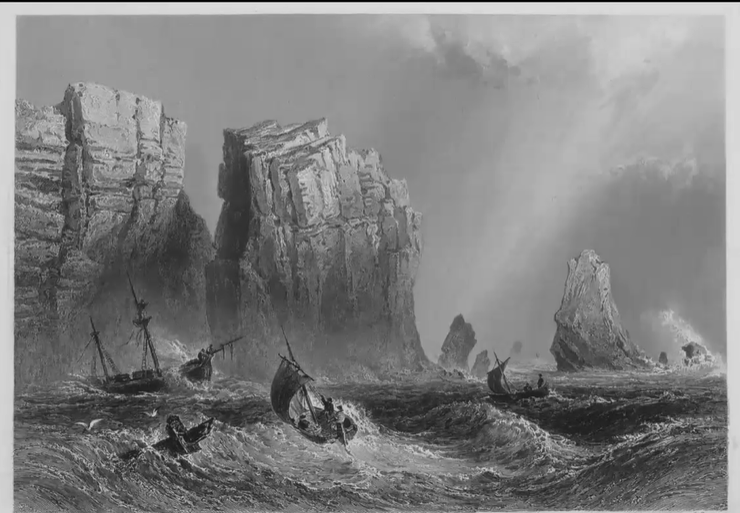
As illustrated below, nice amethyst can be found along this coast.
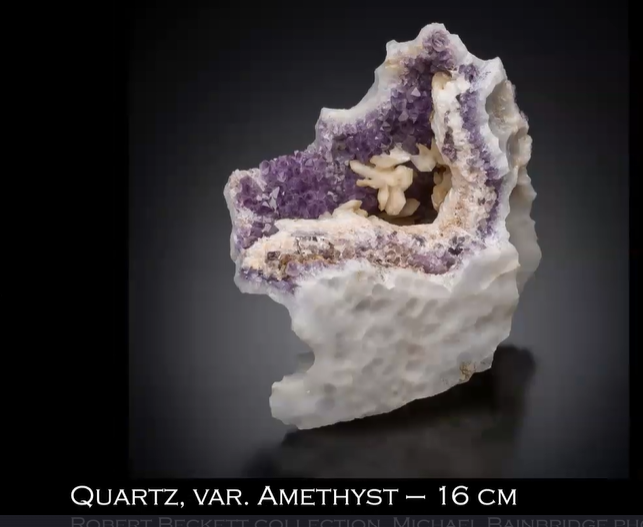
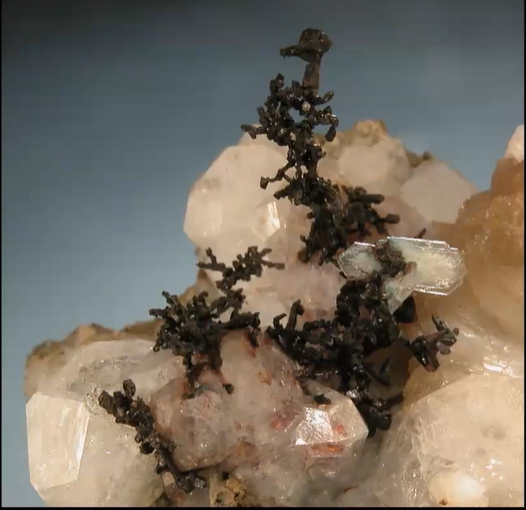
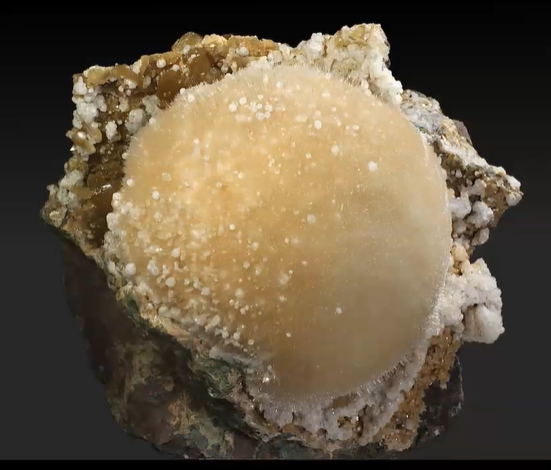
Ray punctuated his presentation with important reminders of what it takes to get to the minerals. The descent from high cliffs, aided by ropes, is difficult enough. But a successful return trip with a now-heavy backpack and full buckets requires careful planning and stamina.
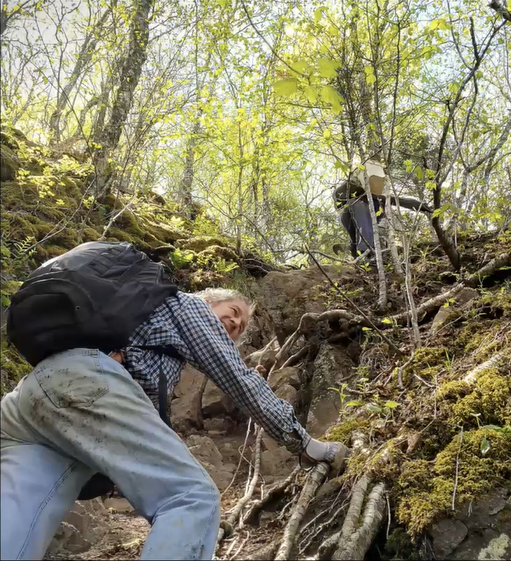
(3) Cap D’Or. It is across the Bay and to the West of Cape Split. The abundance of broken rock shown below at the base of its cliffs makes clear the extraordinary power of the tidal surges and scouring currents.
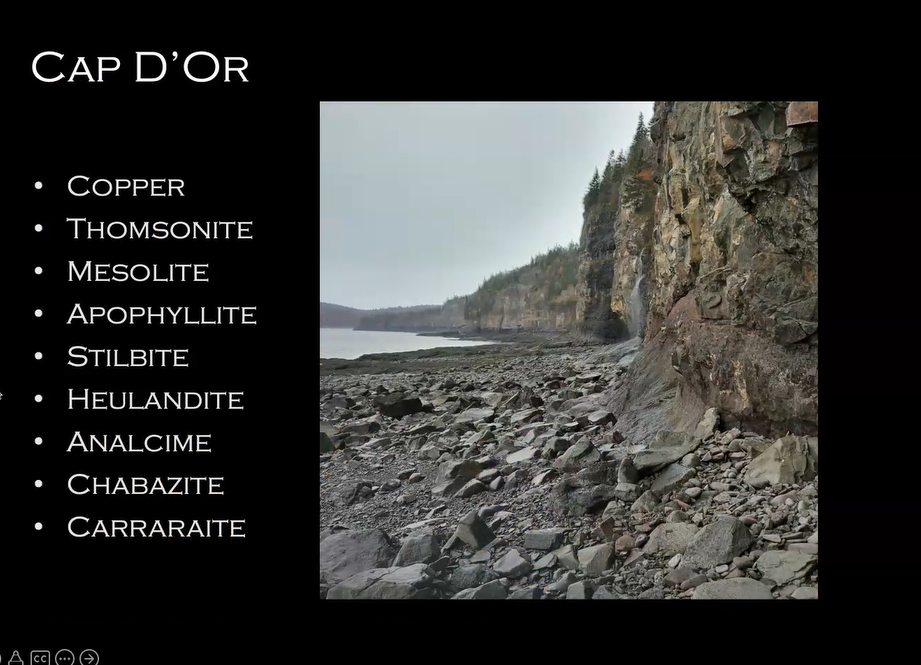
Of the nine primary minerals found in this area, stilbite and mesolite are the most common and copper specimens are among the best. For the other six, finding specimens are “hit or miss but the hits can be spectacular.”
The illustration below shows the currents into and out of the Minas Channel of the Bay. If viewers look carefully and note the reddish-orange-arrows, that is the site off Cap D’Or that has very high waves which are known as destroyers of small boats as depicted in the 1842 engraving shown earlier.
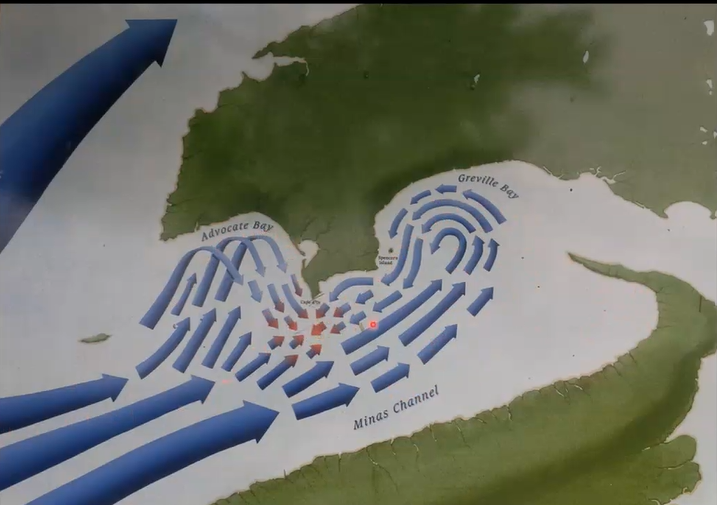
There are historical accounts of the Colonial Copper Mine which Ray suggested may have been rooted in actual efforts to develop a mine, but also may have been the product of a stock market speculation. Nonetheless, the cliffs do yield attractive specimens, such as the specimen in David Joyce’s collection known as “Copper Man”, shown below.
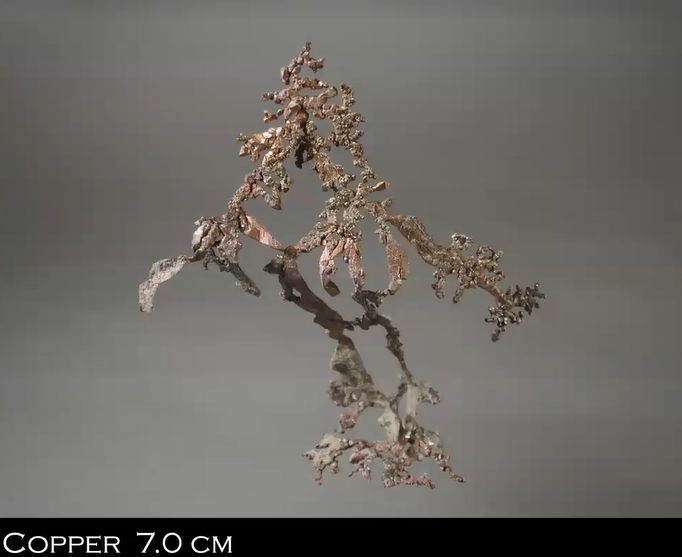
Below is a specimen from the collection of Canadian collector Bob Beckett. It is one of the most astounding specimens Ray has ever seen come out of the Bay of Fundy sites. The dendritic looking copper specimen is embedded in a rock with a 5 cm specimen of spinel law twin attached to the left side.
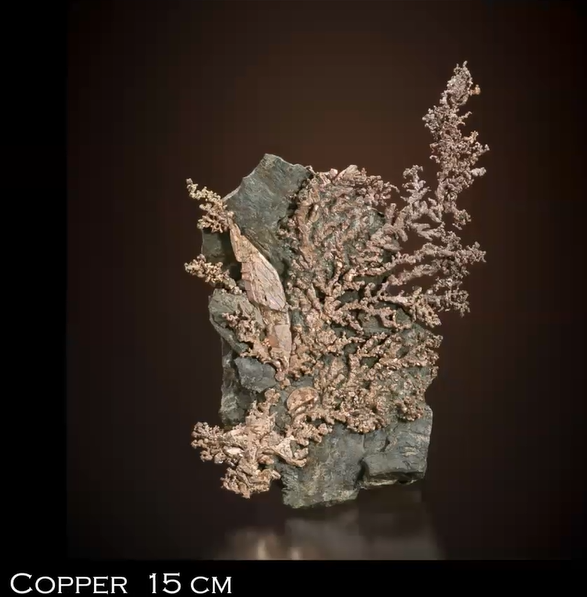
Occasionally collectors find copper included inside other mineral crystals. Below is a beautiful specimen with crystallized copper inside transparent chabazite crystals that are coated with chrysocolla. To date, this combination seems to be a “one of a kind” discovery. But, Ray optimistically says, you never know for sure and so this prompts collectors to return to the specific area with hope.
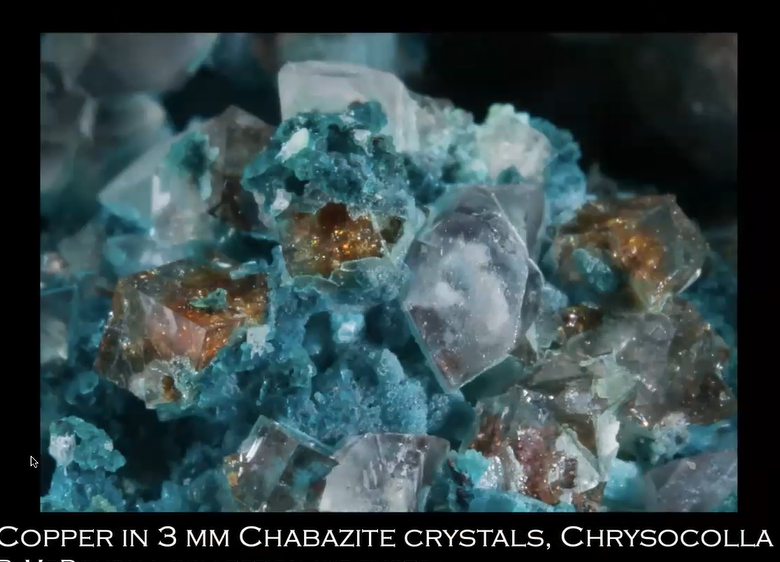
Below is a specimen from Ronnie Van Dommelen’s collection, exhibiting Ray’s favorite thomsonite ball shape from Cap D’Or – these crystals are glassy and highly lustrous, which is very uncommon for thomsonite.
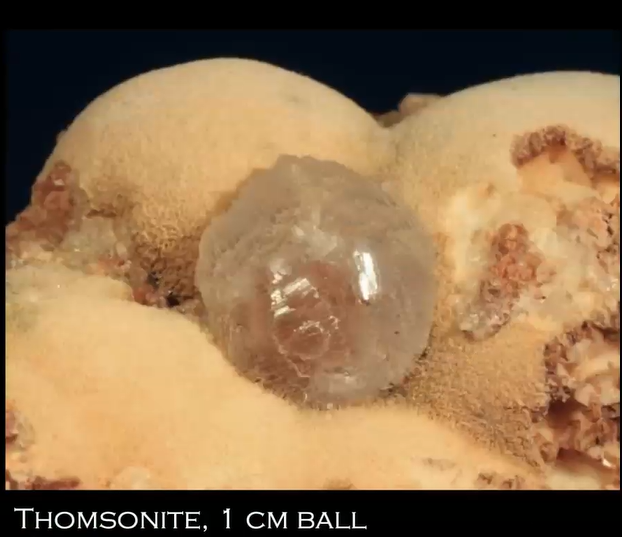
Below is a carraraite, named after the locality for the famous pure white marble, Carrara, Italy. It is a super rare mineral, and this might be the world’s best specimen. It is a compound sulfate (with carbonate) and germanium. “We don’t know where the germanium comes from.”
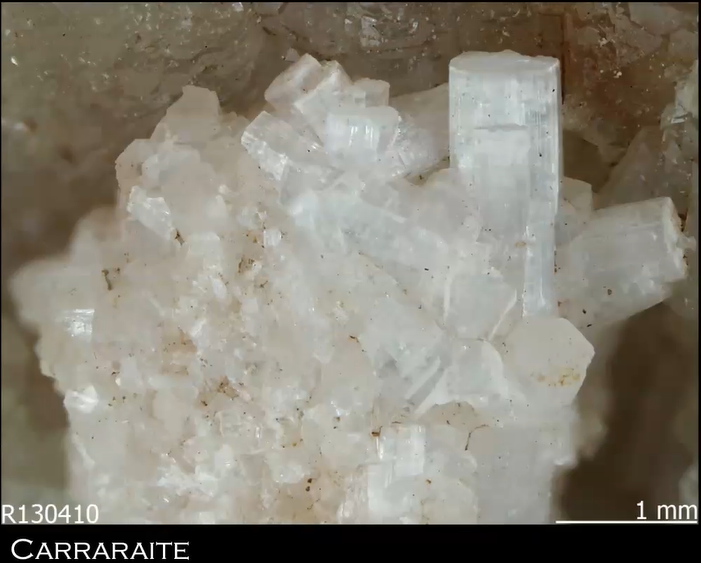
“We’ve been looking for more without success and we’re hoping the cliff will drop us more someday.”
(4) Two Islands and Five Islands. Relatively close to Wasson’s Bluff, Two Islands and Five Islands have been known for mineral specimens since the mid-nineteenth century.
The photo below was taken from the larger of the Two Islands, known locally as “the brothers”, looking out toward its smaller brother. Ray said he loves collecting on these islands, and some of his finds make it clear why this is the case.
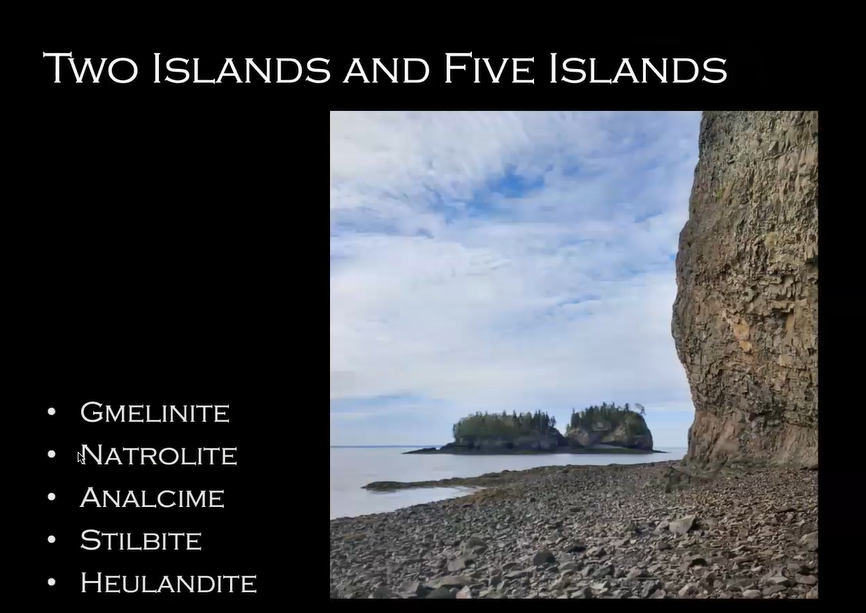
“Two Islands is best known for world class gmelinite.”
Sometimes while on the islands, the openings and pockets look very promising from a distance, but up close there’s not even any crystalized quartz and it turns out to be “junk rock.”
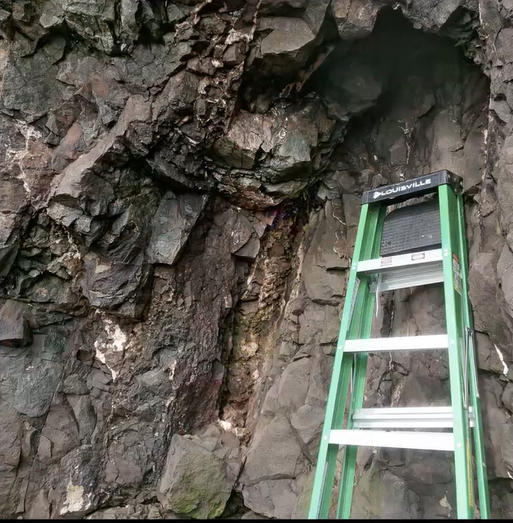
However, some of the cavities contain wonderful crystals of gmelinite. Most of the examples are brilliant and glossy and range in size from the 1 cm specimen below.
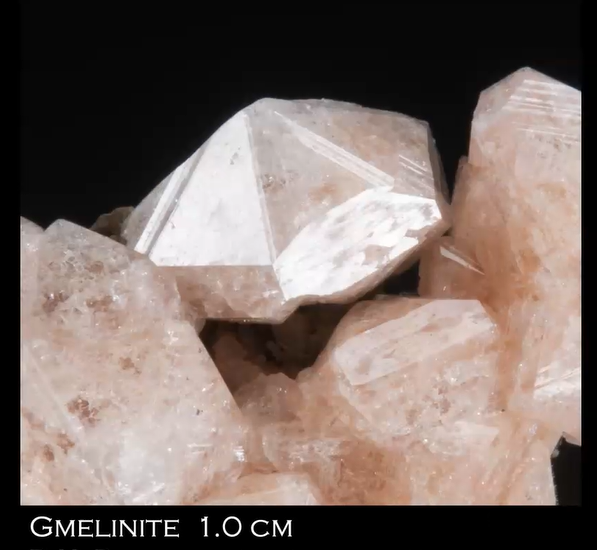
Many of the gmelinite crystal faces show distinct growth features, as seen in the image below.
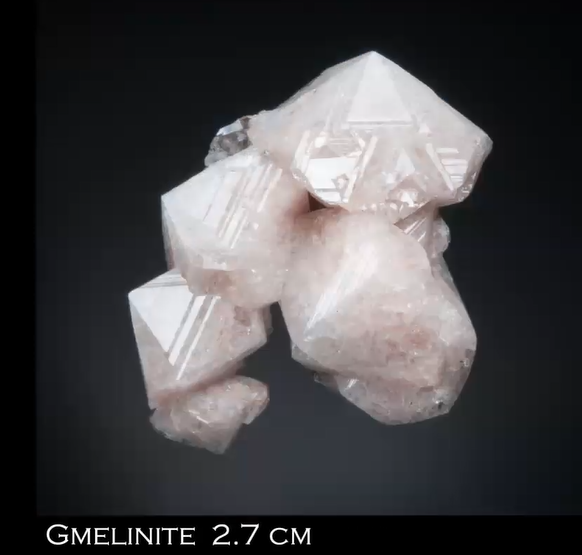
This specimen from Ronnie Van Dommelen’s collections is one of the best Nova Scotia gmelinites known.
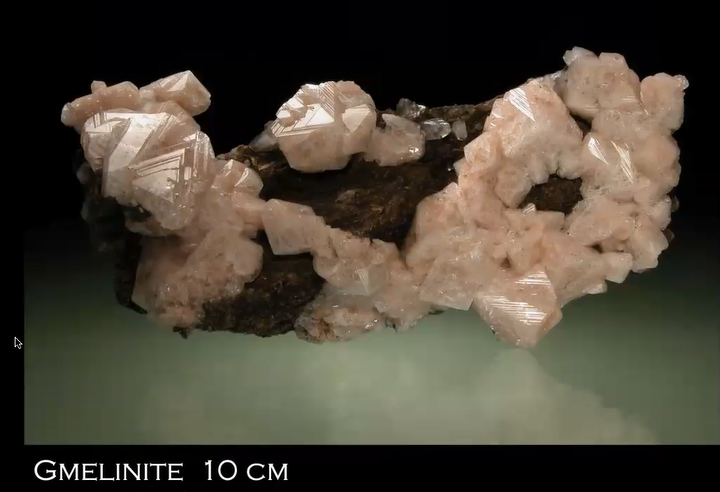
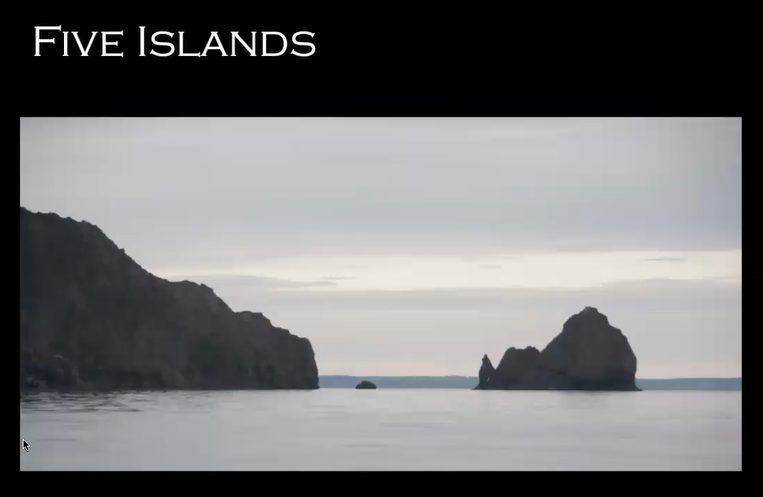
The Five Islands complex provides wonderful before and after contrasts showing the transformations due to tidal activity. In Ray’s photos below, he first shows the landscape at mid-tide.
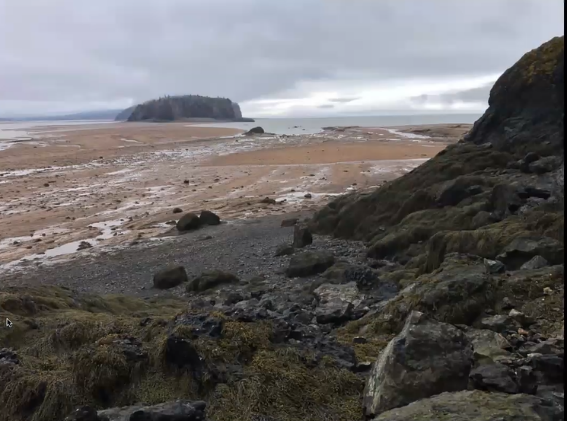
Then the second photo below shows that same view at high tide. The contrast is stunning.
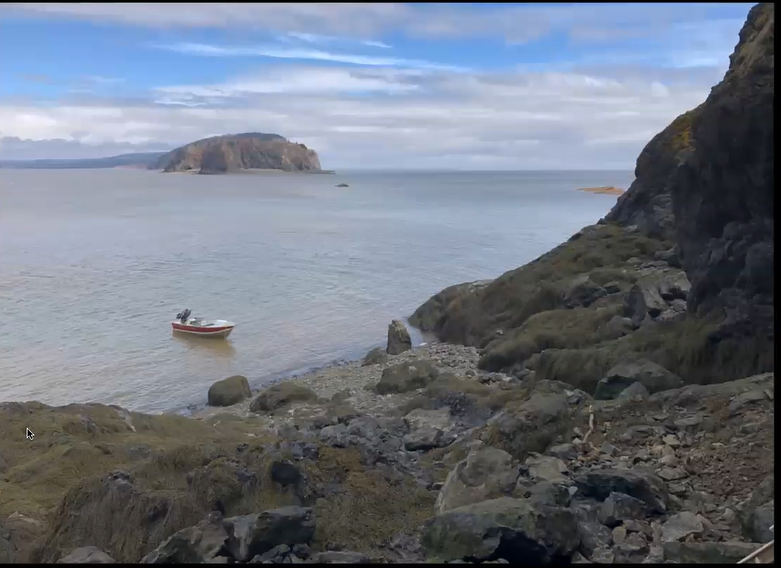
Similarly, the following photo shows Pinnacle Rock viewed at high tide.
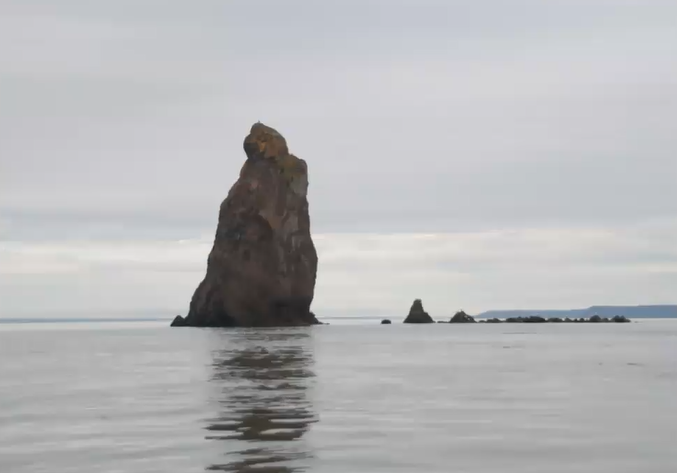
The photo below shows Pinnacle Rock at low tide. Given that access to these islands occurs only by means of a boat, what do collectors do with their boat while they are on land collecting? Sometimes, during low tide, Ray said, the boat can be left unattended. But at other times, to avoid it getting stuck in the mud, the boat must be attended by a guide and moved into deeper water to remain available.
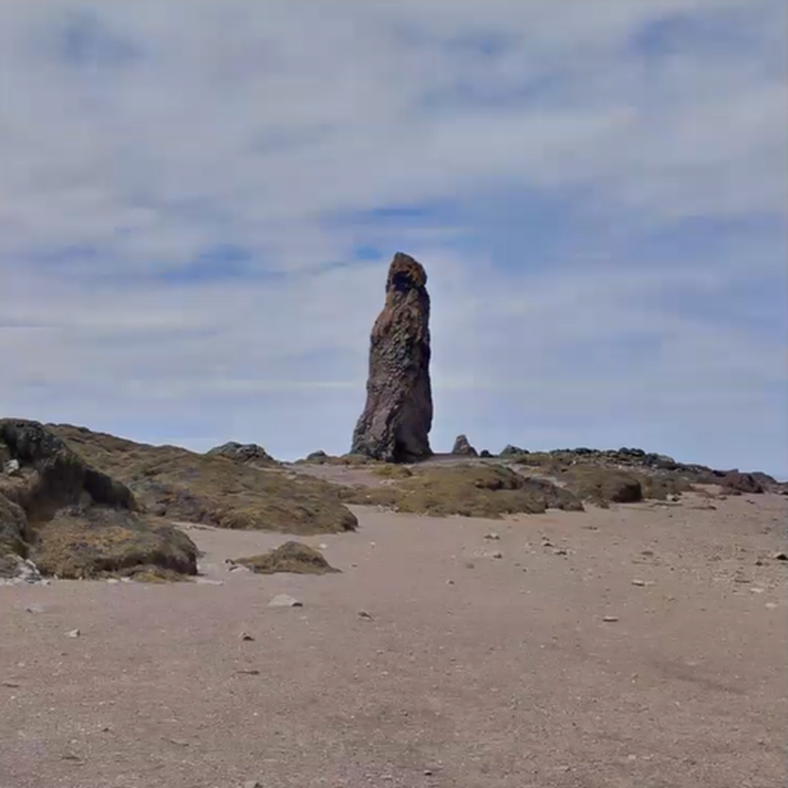
The rocky pinnacles sometimes have interesting mineral specimens, including gmelinite pseudomorphs after chabazite, pictured below, above the hammer as light orange seams.
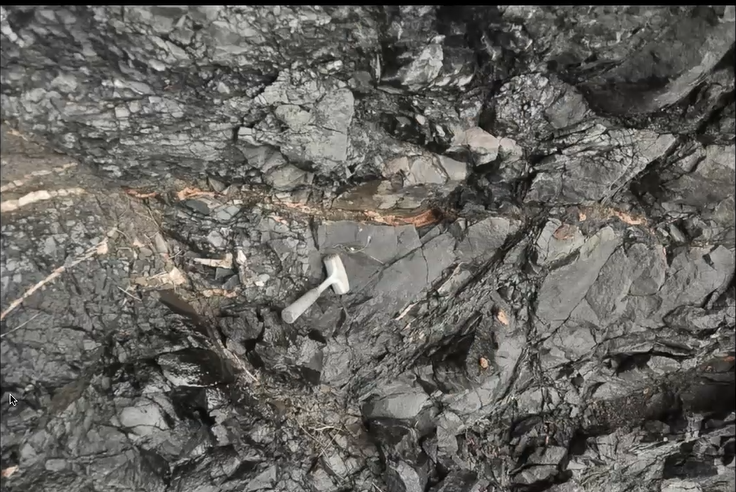
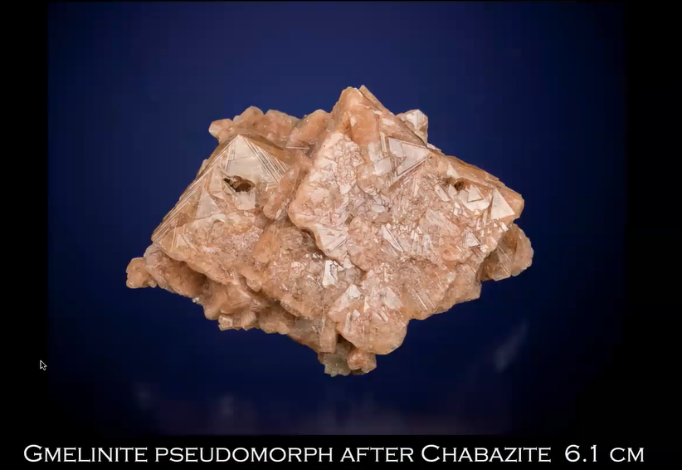
Pictured below are two remarkable gmelinite pseudomorphs after chabazite from Five Islands. The first one, from Ronnie Van Dommelen’s collection, is one of the best ever found. Note that the crystal on the right shows the chabazite contact twinning forms.
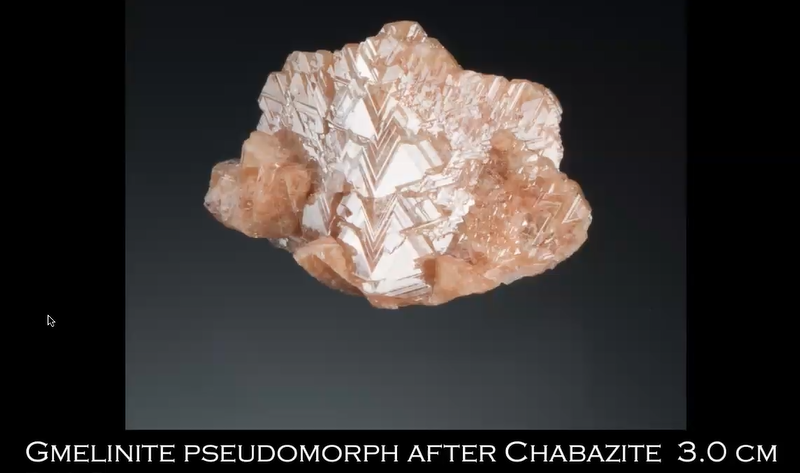
Sometimes there are small traces of the original chabazite, inside or beneath the amazing gmelinite crystal patterns.
Also found at Five Islands are natrolite crystals. Shown below is a 13 cm spray atop an analcime cluster.
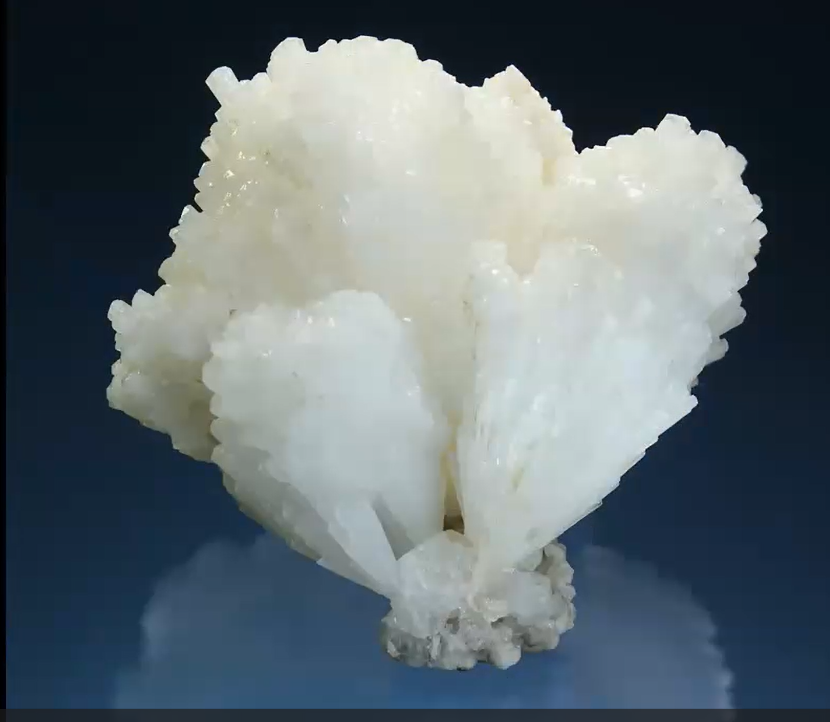
The stilbite specimens, exemplified below, come in beautiful colors and shapes “which can light up a mineral cabinet.”
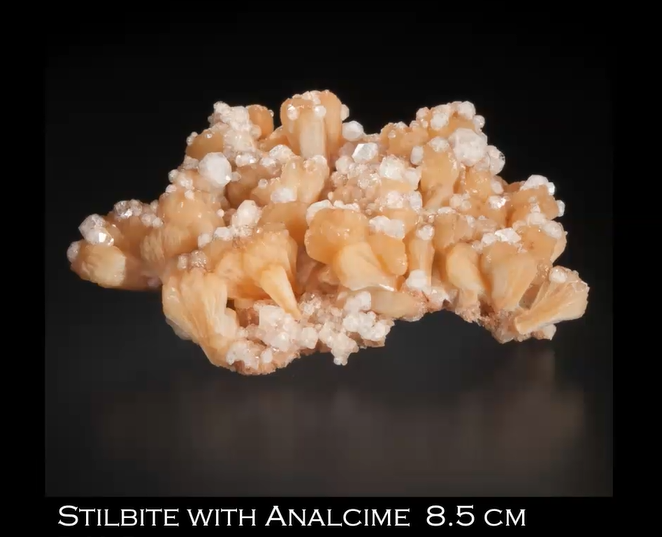
Conclusion

As noted early on in his presentation, for Ray, collecting is a team endeavor. He concluded by thanking his many friends named in the slide below who together made this presentation possible. In each of his slides of minerals he showed during his presentation, Ray provided and gave credit to the mineral’s owners and identified in which collection the specimens currently reside.
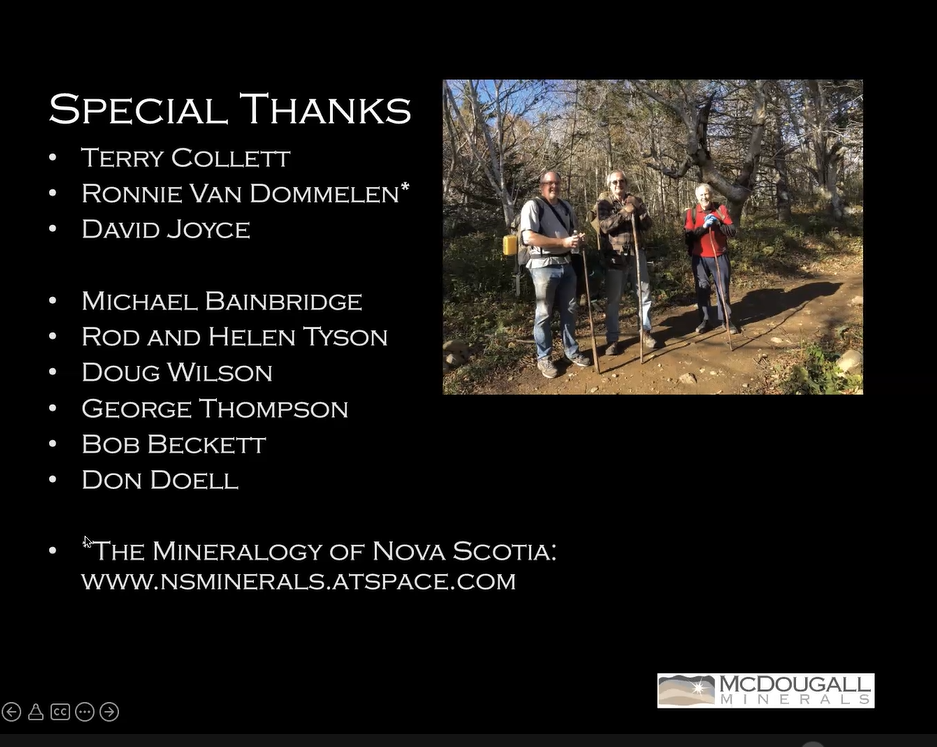
To see the video of Ray McDougall’s presentation, click on the link below. There you will be treated to his collecting stories and photos of the minerals he and his friends found in Bay of Fundy region, Nova Scotia. The King of Tides: Minerals of the Bay of Fundy - Ray McDougall
